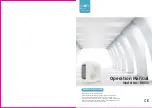
iom-cliv-cf-eng
www.clima-flex.com
17
Refrigerant Charge
Any system that has been exposed to the atmosphere must be
properly dehydrated. This is achieved with a proper vacuum
procedure.
To achieve a proper vacuum, a VACUUM PUMP (not a
compressor) and a VACUOMETER are required.
The procedure is as follows:
• First of all, the access points to the system must be defined.
For both the low side (suction line) and the high side (liquid
line), use the existing service valves on the condensing
unit, i.e. the high pressure switch, connected to the smaller
diameter pipe, and the low pressure switch, connected to the
larger diameter pipe.
• Once this is done, you are ready to evacuate the system.
Basically, it can be done in two ways:
•
DILUTION METHOD
1. Turn on the vacuum pump and build up vacuum in the pump
(register 1 closed).
2. Open register 1 and let the system evacuate until it reaches at
least 500 mcron. To obtain the measurement, close register
1 and open register 2 and make the vacuum gauge feel the
system pressure. After reaching 500 mice, isolate the vacuum
pump and open register 3, letting the Nitrogen pass through
to break the vacuum. Isolate the Nitrogen tube.
3. Vent the Nitrogen through the connection between the copper
line and register 3.
4. Repeat the operation at least twice, making the third evacua-
tion in the last phase. At the end at least 200 mice should be
obtained.
!
WARNING
!
Never disconnect the copper tubing from register 3, simply
loosen the connection to purge the nitrogen.
To obtain an accurate vacuum value, isolate the vacuum pump
from the system by closing register 1 and waiting about 5 minutes
for an accurate measurement. If the value does not hold, the
system still has moisture or there is a leak. Always check all
connections (points 1, 3 and valves).
•
HIGH VACUUM METHOD
It is applied with a vacuum pump capable of achieving a vacuum of
less than 200 microns in a single evacuation. Proceed as follows:
1. Turn on the vacuum pump and then open the register1 (Fig.
12). Subsequently, isolate the vacuum pump and open the
register.
2. When a value of less than 200 mecrons is obtained (try to
reach the lowest possible value), the vacuum procedure is
finished.
!
WARNING
!
The pump oil should be changed periodically to ensure
vacuum efficiency.
REFRIGERANT CHARGE
EMPTYING PROCEDURE
After evacuating the system properly, close the manifold registers
and isolate the vacuum pump, vacuum gauge and nitrogen tube.
To make the refrigerant gas charge, replace the Nitrogen tube
(Figure 12) with a refrigerant gas tube. Purge the hose connecting
the tube to the service valve.
Open the service valve that provides access to the refrigerant gas
tube and then the manifold high register.
To properly charge the system, check the unit identification labels
for the amount of refrigerant gas to be added to the system.
With the system stopped, charge the liquid refrigerant gas through
the liquid line service valve (smaller diameter). To assist you, use
a scale (if a graduated tube is not used). Wait at least 10 minutes
before turning on the equipment.
Close the manifold discharge register, open the suction register
and with the system running complete the charge with refrigerant
gas in gas form (5% to 20% of the total). Check on the scale the
weight of the refrigerant gas that was added to the system. If the
charge is complete close the manifold suction register, disconnect
the suction and discharge hoses and close the pipe register.
The loading procedure is completed.
If for any reason there is a need to remove/lose refrigerant gas,
the service valves on these units allow the refrigerant gas to be
collected from the system inside the condensing unit.
Procedure:
1. Connect the manifold hoses to the service valve ports of the
condensing unit.
2. Close the 1/4” liquid line service valve.
3. Turn the unit on cool down observing that the system pres-
sures reach 2 psi.
At this time close the 3/8” suction line service valve to allow the
refrigerant gas to be collected.
REFRIGERANT GAS RECOVERY
NOTE: The refrigerant must be adjusted by 20% to reach the
evaporating temperature. You can check the charge
on the next page.
















































